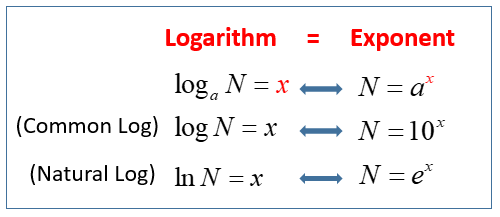Common and Natural Logarithm
Related Pages
Logarithmic Functions
Properties Or Rules Of Logarithms
Rules Of Exponents
Logarithm Rules
In these lessons, we will learn common logarithms and natural logarithms and how to solve problems using common log and natural log.
The common logarithm is a logarithm with base 10. It is denoted as log10(x) or simply log(x). It is used to solve problems involving powers of 10.
The natural logarithm is a logarithm with base e, where e is the mathematical constant approximately equal to 2.71828. It is denoted as ln(x).
The relationship between logarithms and exponents is fundamental in mathematics. Logarithms and exponents are inverse operations, meaning they “undo” each other.
The following diagrams gives the definition of Logarithm: Common Log, and Natural Log. It also shows the relationship between logs and exponents. Scroll down the page for more examples and solutions.

Logarithms and exponents are inverse functions. This means:
If y = bx, then x = logb(y).
Similarly:
If x = logb(y), then y = bx.
Common Logarithms
Logarithms to base 10 are called common logarithms. We often write “log10” as “log” or “lg”. Common logarithms can be evaluated using a scientific calculator.
Recall that by the definition of logarithm.
log Y = X ↔ Y = 10X
Natural Logarithms
Besides base 10, another important base is e. Log to base e are called natural logarithms. “loge” are often abbreviated as “ln”. Natural logarithms can also be evaluated using a scientific calculator.
By definition
ln Y = X ↔ Y = eX
Using a calculator, we can use common and natural logarithms to solve equations of the form ax = b, especially when b cannot be expressed as an.
Example:
Solve the equations
a) 6x + 2 = 21
b) e2x = 9
Solution:
a) 6x + 2 = 21
log 6x + 2 = log 21
(x + 2) log 6 = log 21

b) e3x = 9
ln e3x = ln 9
3x ln e = ln 9
3x = ln 9

Example:
Express 3x(22x) = 7(5x) in the form ax = b. Hence, find x.
Solution:
Since 3x(22x) = 3x(22)x = (3 × 4)x = 12x
the equation becomes
12x = 7(5x)

Common And Natural Logarithms
We can use many bases for a logarithm, but the bases most typically used are the bases of the common logarithm and the natural logarithm. The common logarithm has base 10, and is represented on the calculator as log(x). The natural logarithm has base e, a famous irrational number, and is represented on the calculator by ln(x). The natural and common logarithm can be found throughout Algebra and Calculus.
Defines common log, log x, and natural log, ln x, and works through examples and problems using a calculator.
Common And Natural Logarithms
Example: Write the following logarithms in exponential form. Evaluate if possible.
Properties Of Logarithms
The logarithm of a Product:
logbMN = logbM + logbN
The logarithm of a Quotient:
logbM/N = logbM - logbN
The logarithm of a number raised to a power:
logbMP = P logbM
How to use the properties of logarithms to condense and solve logarithms?
How to use the properties of logarithms to expand logarithms?
Common And Natural Logs
Examples:
Solve without a calculator:
log33
log 1
log162
ln e3
Solve with a calculator:
log 3
log 32
ln √5
ln 7.3
How to solve logarithmic equations?
The first example is with common logs and the second example is natural logs. It is good to remember the properties of logarithms also can be applied to natural logs.
Examples:
Solve, round to four decimal places.
- log x = log2x2 - 2
- ln x + ln (x + 1) = 5
Try out our new and fun Fraction Concoction Game.
Add and subtract fractions to make exciting fraction concoctions following a recipe. There are four levels of difficulty: Easy, medium, hard and insane. Practice the basics of fraction addition and subtraction or challenge yourself with the insane level.

We welcome your feedback, comments and questions about this site or page. Please submit your feedback or enquiries via our Feedback page.